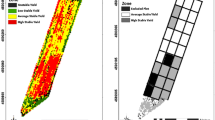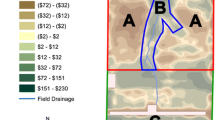Abstract
Precision agriculture (PA) technologies allow us to assess field variability and support site-specific (SSP) application of inputs. The joint application of PA and organic farming practices might be synergetic. The objective of this 3-year study was to propose a multivariate statistical and geostatistical approach, to evaluate the effects of SSP nitrogen (N) fertilization on durum wheat in transition to organic farming. Soil parameters were measured to assess soil fertility level before the SSP fertilization on wheat, which was carried out by management zones in the third year. Radiometric measurements were performed with a hyperspectral spectroradiometer and N-uptake at anthesis and grain yield were determined. The expected values and 95 % confidence intervals of the soil parameters, N-uptake and yield data were estimated with polygon kriging for each management zone. Reflectance data were reduced through principal component analysis and the retained principal components were submitted to factorial co-kriging analysis to estimate orthogonal scale-dependent factors. Comparisons between N-uptake and yield and between the retained regionalized factors (F1) and yield were performed. The spatial pattern of F1 at shorter scales was mostly reproduced in the N-uptake map, suggesting the predictive capacity of hyperspectral data for crop N-status. Within-cluster variance for yield was reduced, quite probably as a combined effect of meteorological pattern and management. The preliminary results seem to be promising in the perspective of PA. Moreover, an inverse relationship between grain yield and crop N-status was observed.








Similar content being viewed by others
References
Barnes, E. M., Clarke, T. R., & Richards, S. E. (2000). Coincident detection of crop water stress, nitrogen status and canopy density using ground based multispectral data. In P. C. Robert, R. H. Rust, & W. E Larson (Eds.), Proceedings of the 5th international conference on precision agriculture. American Society of Agronomy, Madison.
Bowker, A. H. (1948). A test for symmetry in contingency tables. Journal of the American Statistical Association, 43, 572–574.
Castrignanò, A., Giugliarini, L., Risaliti, R., & Martinelli, N. (2000). Study of spatial relationships among some soil physico-chemical properties of a field in central Italy using multivariate geostatistics. Geoderma, 97, 39–60.
Chilès, J. P., & Delfiner, P. (1999). Geostatistics: Modelling spatial uncertainty. New York: Wiley.
Cohen, J. (1960). A coefficient of agreement for nominal scales. Educational and Psychological Measurement, 20, 37–46.
Diacono, M., Abd El Rahman, H., Cocozza, C., De Benedetto, D., Troccoli, A., Rubino, P., et al. (2011). Delineation of homogeneous field zones based on soil fertility indices in a durum wheat—Chickpea rotation. In J. V. Stafford (Ed.), Precision agriculture 2011 (pp. 164–179). UK: Ampthill.
Diacono, M., Castrignanò, A., Troccoli, A., De Benedetto, D., Basso, B., & Rubino, P. (2012). Spatial and temporal variability of wheat grain yield and quality in a Mediterranean environment: A multivariate geostatistical approach. Field Crops Research, 131, 49–62.
Digital Globe. (2009). White Paper. The Benefits of the 8 Spectral Bands of WorldView-2. (p. 10). Retrieved from www.digitalglobe.com.
FAO. (1995). Sustainability issues in agricultural and rural development policies, Trainer’s manual, vol 1.
Geovariances. (2012). Isatis® Technical Ref., 12.04 Geovariances and Ecole Des Mines De Paris: Avon Cedex, France.
Horneck, D. A., & Miller, R. O. (1998). Determination of total nitrogen in plant tissue. In Y. P. Kalra (Ed.), Handbook of reference methods for plant analysis (pp. 75–83). Boca Raton: CRC Press.
Kaiser, H. F. (1960). The application of electronic computers to factor analysis. Educational and Psychological Measurement, 20, 141–151.
Lajaunie, C., & Béhaxétéguy, J. P. (1989). Elaboration d’un programme d’ajustement semi-automatique d’un modèle de corégionalisation—Theorie, technical report N21/89/G. Paris: ENSMP.
Li, F., Miao, Y., Hennig, S. D., Gnyp, M. L., Chen, X., Jia, L., et al. (2010). Evaluating hyperspectral vegetation indices for estimating nitrogen concentration of winter wheat at different growth stages. Precision Agriculture, 11, 335–357.
Li, F., Miao, Y., Zhang, F., Cui, Z., Li, R., Chen, X., et al. (2009). In-season optical sensing improves nitrogen-use efficiency for winter wheat. Soil Science Society of America Journal, 73, 1566–1574.
Maeder, P., Fliessbach, A., Dubois, D., Gunst, L., Fried, P., & Niggli, U. (2002). Soil fertility and biodiversity in organic farming. Science, 296(5573), 1694–1697.
Matheron, G. (1982). Pour une analyse krigeante des données régionalisées. Rapport N-732. Centre de Géostatistiques, École des Mines de Paris, Fontainebleau.
Mueller, N. D., Gerber, J. S., Johnston, M., Ray, D. K., Ramankutty, N., & Foley, J. A. (2012). Closing yield gaps through nutrient and water management. Nature, 490(7419), 254–257.
Page, A. L., Miller, R. H., & Keeny, D. R. (1982). Methods of soil analysis, Part II (2nd ed.). Madison, WI: American Society of Agronomy.
Prasad, B., Carver, B. F., Stone, M. L., Babar, M. A., Raun, W. R., & Klatt, A. R. (2007). Potential use of spectral reflectance indices as a selection tool for grain yield in winter wheat under Great Plains conditions. Crop Science, 47, 1426–1440.
Ray, S. S., Singh, J. P., & Panigraphy, S. (2010). Use of hyperspectral remote sensing data for crop stress detection: Ground-based studies. International Archives of Photogrammetry, Remote Sensing and Spatial Information Science, vol. 38, Part 8. Kyoto, Japan.
SAS Institute Inc., (2012). SAS/STAT software release 9.3. Cary, NC: SAS Institute.
Shepherd, M. A., Davies, D. B., & Johnson, P. A. (1993). Minimizing nitrate losses from arable soil. Soil Use and Management, 9(6), 94–99.
Soil Survey Staff. (1999). Soil taxonomy: A basic system of soil classification for making and interpreting soil surveys. Agriculture Handbook No. 436, 2nd edn. Washington, DC: U.S. Gov. Print. Office.
Stellacci, A. M., Castrignanò, A., Diacono, M., Troccoli, A., Ciccarese, A., Armenise, E., et al. (2012). Combined approach based on principal component analysis and canonical discriminant analysis for investigating hyperspectral plant response. Italian Journal of Agronomy, 7, 247–253.
Stroppiana, D., Boschetti, M., Brivio, P. A., & Bocchi, S. (2009). Plant nitrogen concentration in paddy rice from field canopy hyperspectral radiometry. Field Crops Research, 111, 119–129.
Thenkabail, P. S., Enclona, E. A., Ashton, M. S., & Van Der Meer, B. (2004). Accuracy assessments of hyperspectral waveband performance for vegetation analysis applications. Remote Sensing of Environment, 91, 354–376.
Tubaña, B. S., Arnall, D. B., Holtz, S. L., Solie, J. B., Girma, K., & Raun, W. R. (2008). Effect of treating field spatial variability in winter wheat at different resolutions. Journal of Plant Nutrition, 31, 1975–1998.
Wackernagel, H. (2003). Multivariate geostatistics: An introduction with applications (3rd ed.). Berlin: Springer.
Walkley, A., & Black, I. A. (1934). An examination of the Degtjareff method for determining organic carbon in soils: Effect of variations in digestion conditions and of inorganic soil constituents. Soil Science, 63, 251–263.
Webster, R., & Oliver, M. (2001). Geostatistics for environmental scientists. Statistics in practice. Chichester: Wiley.
Zadoks, J. C., Chang, T. T., & Konzak, C. F. (1974). A decimal code for the growth stages of cereals. Weed Research, 14, 415–421.
Acknowledgments
The work has been supported by Italian Ministry of Agriculture and Forestry Policies under contract no. 24324/7742/2009 (“Sistemi colturali e interventi agronomici innovativi in agricoltura biologica” BIOINNOVA, Coordinator: Dr. Domenico Ventrella, CRA—SCA, Research Unit for Cropping Systems in Dry Environments, Bari). The authors thank M. Mastrangelo for his skilful technical assistance for chemical analysis. This work was benefited from the fertilizer supplying for free from the ILSA S.p.A. (Dr. Eugenio Babini). The authors wish to thank also the John Deere Company (Dr. Matteo Antonello).
Author information
Authors and Affiliations
Corresponding author
Rights and permissions
About this article
Cite this article
Diacono, M., Castrignanò, A., Vitti, C. et al. An approach for assessing the effects of site-specific fertilization on crop growth and yield of durum wheat in organic agriculture. Precision Agric 15, 479–498 (2014). https://doi.org/10.1007/s11119-014-9347-8
Published:
Issue Date:
DOI: https://doi.org/10.1007/s11119-014-9347-8




